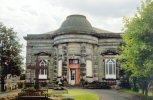
The farmland on which the church and grounds sit was feued from the Marquis of Abercorn in 1825 by the church founders Lieut. Col. Halyburton & his wife Eliza and James & Susannah Rutherford. They rapidly had the “chapel” erected at their own expense and it was opened in May 1828.
The Vestry soon sought the right to open a burying ground around the chapel but became embroiled in a dispute with the owner of a neighbouring villa who insighted the Kirk Session of Duddingstone, who had also opened a burying ground, to engage in litigation with St. Marks. The case was eventually decided in favour of St. Marks and the burying ground was consecrated on 11 November 1828 by Bishop Sandford. The first recorded burial service took place a month later.
Lairs were either purchased or leased for periods of fourteen years after which the Vestry was entitled to make further use of any lair upon which the lease had not been renewed “and to cause all Tombstones, Monuments or Tablets placed thereon to be removed”! Purchasers were bound to “enclose their respective Lots with Boundary & Division Walls...At least six feet in depth below the surface”. The 1859 Lair Plan shows evidence these walls were erected, however nothing can be seen above ground today.
Early management of the burial ground appears to have been chaotic. The first lair plan was lost and a new plan made in 1859, however problems soon arose when lairs in the area immediately behind the church, which were believed to be vacant were found to be occupied.
The problem proved so great that the Vestry prohibited all further internments in December 1862 except in Block C and the border on the east boundary wall. Unfortunately it “proved difficult to dispose of this ground, as no-one like[d] the position".
The consequent shortage of available lairs resulted in plans to remove the trees in the side borders in front of the church so as to use the ground for burials.
Further problems arose at the end of the nineteenth century when the chancel was added to the church. The unusual construction which can be seen today arose from the need to span the structure over occupied lairs beneath.
The burial ground continues to be used to this day.
Records of past lives
The real interest of the burial ground is the record of past lives that it provides. In the early eighteenth century there was a large influx of military and naval officers into Portobello. Many of them were Episcopalians and St Mark’s soon became favoured by them. This is reflected in the high occurrence of early monuments dedicated to officers and their families. Of particular note is the memorial in front of the church entrance to Lieut. Col. Halyburton himself, late of the 7th Royal Fusiliers. More poignant is the recently renewed memorial to Joseph Huey MD, Assistant Surgeon, 14th Kings Light Dragoons, erected by his brother officers as a mark of their esteem and regard.
Eight of St Mark’s rectors are buried in the grounds, including the first rector George Maurice Drummond who worked tirelessly for the poor of Portobello through the Portobello Destitute & Sick Society.
There are also records of great loss. That of Rev. Boyle who buried two wives in four years. The second “died to his inexpressible grief and her remains together with those of her only child” are buried at the rear of the church.
Close by are the five children of Mr & Mrs Gow, three of whom died in the same year
In the side border in front of the church is the war grave of Flight Sergeant H. I Sandison, Navigator (Bomber) twenty one, who died in a plane crash together with his fellow crew members in 1846. The church sacristy lamp is dedicated to their memory.

1 comment:
Sally has pointed out to me that the date in the last paragraph should probably be 1946 and not 1846. I haven't found where to edit things yet so a comment will have to do!
Post a Comment